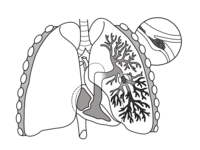
Photo from wikipedia
Since the landmark study by Haïssaguerre et al., catheter ablation targeting the pulmonary veins has become pivotal inmanaging paroxysmal atrial fibrillation [1]. The sustained durable electrical isolation of the pulmonary… Click to show full abstract
Since the landmark study by Haïssaguerre et al., catheter ablation targeting the pulmonary veins has become pivotal inmanaging paroxysmal atrial fibrillation [1]. The sustained durable electrical isolation of the pulmonary veins by creating atrial lesions remains the target of the procedure. Consequently, lesion assessment is the cornerstone of the same. Incomplete lesions can lead to reconnection of the veins and may predispose to flutter circuits that may paradoxically make the patient more symptomatic than before. Too much delivery of radiofrequency (or cryoenergy) into the atrial tissues carries the risk of collateral damage to the adjacent structures risking severe complications such as atrio-esophageal fistula [2]. The size of ablation lesions using an irrigated radiofrequency catheter is proportional to the contact force, power, and time delivered [3,4]. Each lesion created within the left atrium represents a choice made by the operator vis a vis the sufficiency of the same. Historically, the techniques and technology have been refined to maximize success, limit procedural time, and minimize complications. The advent of irrigated ablation catheters, intracardiac echocardiography, and contact force have been steps in this direction [5]. However, radiofrequency duration, power, and contact force to deliver the optimal lesion, and interlesional distance to avoid reconnection of the pulmonary veins has not been wellestablished. Traditional assessment of local lesion completeness has been based on assessing impedance fall during energy delivery, the change in the morphology of the bipolar electrogram, fractionation of the signal, or the development of double potentials [6e9]. Most electroanatomic mapping systems have provided visual graphical representation for the fall in local impedance due to the ablation lesion. However, the other parameters suffer from a lack of standardized representation and depend on operator assessment. In this issue, Theis et al. examine the use of the Ablation Index (AI), a composite measure of force, power, and time along with
Journal Title: Indian Pacing and Electrophysiology Journal
Year Published: 2021
Link to full text (if available)
Share on Social Media: Sign Up to like & get
recommendations!